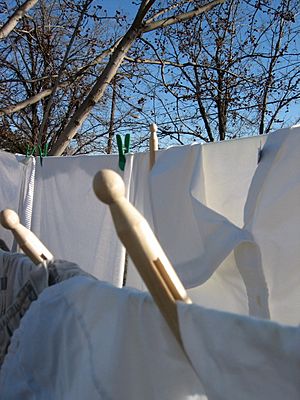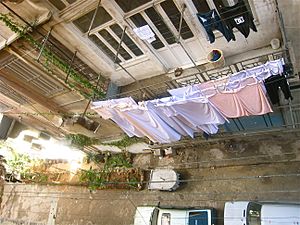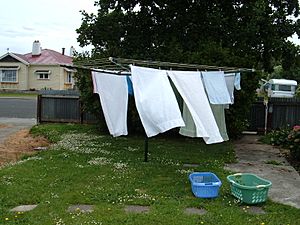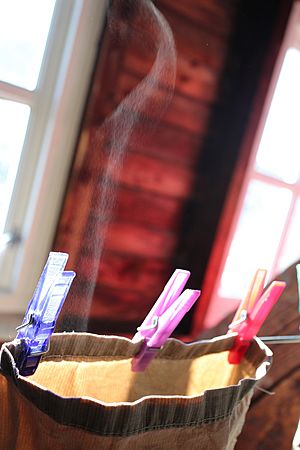Clothesline facts for kids

A clothes line or washing line is any type of rope, cord, or twine that has been stretched between two points (e.g. two sticks), outside or indoors, above the level of the ground. Clothing that has recently been washed is hung along the line to dry, using clothes pegs or clothespins. Washing lines are attached either from a post or a wall, and are frequently located in back gardens, or on balconies. Longer washing lines often have props holding up sections in the middle due to the weight of the usually wet clothing.
More elaborate rotary washing lines save space and are typically retractable and square or triangular in shape, with multiple lines being used (such as the Hills Hoist from Australia). Some can be folded up when not in use (although there is a very minor hazard of getting fingers caught, so there is usually a safety button).
In Scotland, many tenement buildings have a "drying green", which is a communal area predominantly used for clothes lines – it may also be used as a recreational space - as well as a clothes horse connected to a pulley system inside which can be used in the frequently cold winter weather.
Comparison

Advantages
- Saves money
- Zero greenhouse gas emissions per load (2 kg CO2eq of greenhouse gas emissions from the average mechanical clothes dryer per load)
- Less fabric wear and tear
- Laundry items do not shrink (hot air from a mechanical clothes dryer may shrink items)
- No static cling and no perfume smells throughout the neighborhood from fabric softener and anti-static dryer sheets.
- Laundry items stay softer to the touch (mechanical clothes dryers tend to remove short, soft, fine fibers), and may be less wrinkled
- Laundry items often do not need ironing if line dried in a breeze
- Avoids the potential of airborne lint and reduced air quality
- Eliminates the noise from a mechanical clothes dryer
- Does not vent indoor air to the outside and waste the large volume of conditioned (heated or cooled) air that a mechanical dryer's blower does.
- For a simple line drying arrangement (rope and clothes pins) the repair and replacement costs are about $20.00 per 1,000 loads of laundry or 2 cents per load. For non-commercial mechanical clothes drying the repair and replacement costs (including labor expenses) are about $200.00 per 1,000 loads of laundry or 20 cents per load.
Disadvantages
- Putting laundry on a line usually takes more time than putting it into a mechanical dryer (as laundry items have to be hung up and fixed one by one).
- Laundry items need to be hung indoors during rainy weather, or may get wet if the weather changes.
- Neighbours may find it aesthetically unpleasant
- Exposing laundry can lessen privacy, showing information about inhabitants' living habits.
- Risk of theft or vandalism of clothes
- Environmental contaminants such as soil, dust, smoke, automotive or industrial pollutants, pollen and bird and animal droppings can come in contact with clothing.
- Clothespins can leave imprints (including rust from the spring) on the clothes.
Drying laundry indoors
Laundry may be dried indoors rather than outdoors for a variety of reasons including:
- inclement weather
- physical disability
- lack of space for a line
- reduce the damage to fabrics from sun's UV rays
- legal restrictions
- to raise the humidity level indoors, and lower the air temperature indoors
- convenience
- to preserve privacy
Several types of devices are available for indoor drying. A drying rack or clotheshorse can help save space in an apartment, or clothes lines can be strung in the basement during the winter. Small loads can simply be draped over furniture or a shower curtain pole. The drying time indoors will typically be longer than outdoor drying because of the lack of direct solar radiation and the convective assistance of the wind.
Images for kids
-
Clotheslines fiber made with polyurethane















